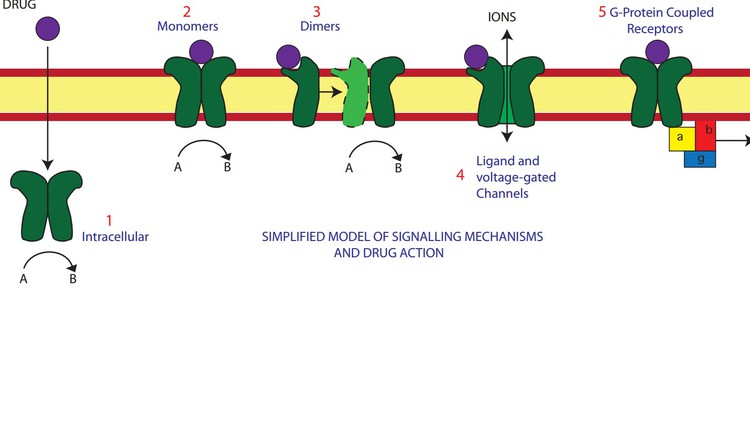
Definition of receptor, Nature of receptors, Regulations of receptors, Transducer mechanism of receptors and enzyme-link
What you will learn
To recall -Definition the receptors, receptor and drug receptor theory
To understand the regulations of receptors: up regulation, down regulation and desensitization of receptors
To know the nature and classification of receptors
To understand the receptor transducer mechanisms
To understand all the types of transducer mechanisms
Description
Definition: It is defined as a macro-molecule or binding site located on cell surface or inside the effector cell that serves to recognize the signal molecule/drug and initiate the response to it, but itself has no other function, e.g. G-protein coupled receptor.
Agonist: An agent which activates a receptor to produce an effect similar to a that of the physiological signal molecule, e.g. Muscarine and Nicotine
Antagonist: an agent which prevents the action of an agonist on a receptor or the subsequent response, but does not have an effect of its own, e.g. atropine and muscarine.
Inverse agonist: an agent which activates receptors to produce an effect in the opposite direction to that of the agonist, e.g. DMCM in BDZ receptors
Partial agonist: An agent which activates a receptor to produce submaximal effect but antagonizes the action of a full agonist,
e.g. opioids
Ligand: any molecule which attaches selectively to particular receptors or sites (only binding or affinity but no functional change).
Receptors has two essential functions:
–Recognition of specific ligand molecule
–Transduction of signal into response
Two Domains:
–Ligand binding domain
–Effectors Domain – undergoes functional conformational change.
CLASSIFICATION OF RECEPTORS:
I. Pharmacological criteria:
Relative potencies of agonists & antagonists
Classical & oldest: direct clinical bearing
Cholinergic, adrenergic & histaminergic receptors
II. Tissue distribution:
Subtypes
Cardiac β-receptor:β1 & bronchial: β2
III. Ligand binding:
Measurement of specific binding of high affinity radiolabelled ligand to cellular fragments in vitro & displacement by selective agonists/ antagonists.
5-HT receptors distinguished.
IV. Transducer pathway:
Mechanism through which activation is linked to the response-
NM – G proteins; NN – Na+ influx
β adrenergic cAMP
α adrenergic IP3- DAG pathway & cAMP
GABAA : ligand gated Cl- channel
Receptors shows three types of regulations such as up regulation, down regulation and desensitization.
Receptor proteins can be classified by their location. Trans membrane receptors include ligand-gated ion channels, G protein-coupled receptors, and enzyme-linked hormone receptors.
There are three different types of receptors specified for first messengers: Ion channel receptors, G-protein-linked receptors, Enzyme linked receptors and gene expression. Transducers: it is the mean through which the first effector is activated. The term transducer usually refers to G proteins.
Most useful drugs in clinical medicine act by mimicking or blocking the actions of endogenous ligands that regulate the flow of ions through plasma membrane channels. Types of ion channel gated receptors is GABA receptor. There are two types of enzyme link receptors.
Content